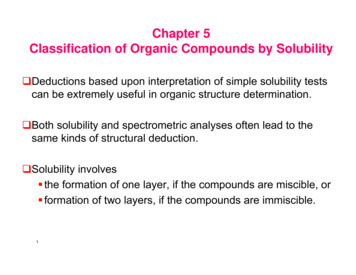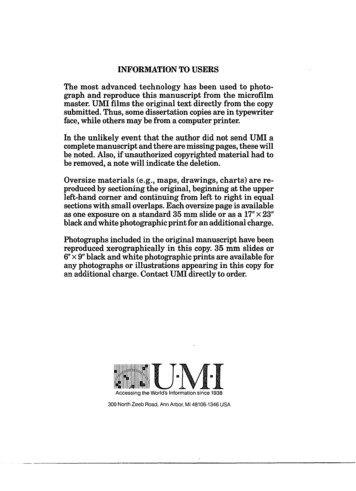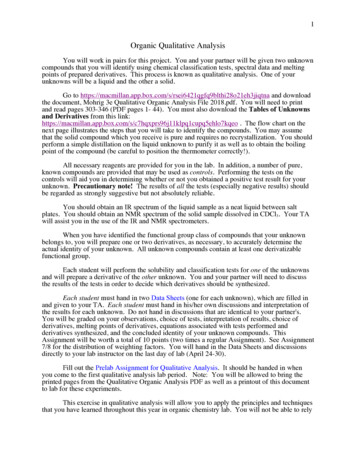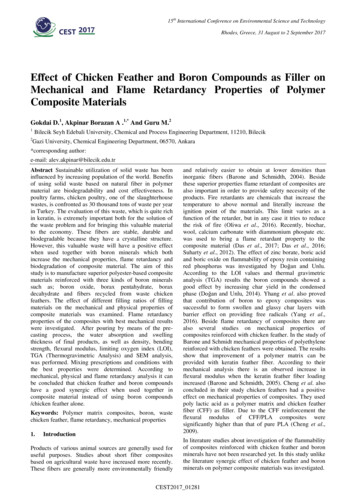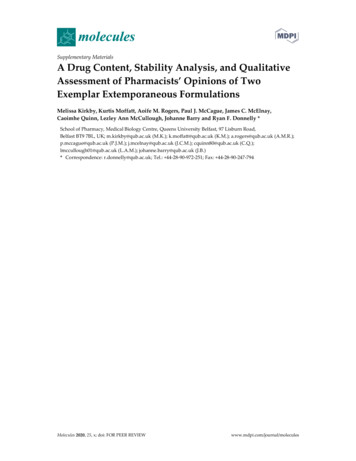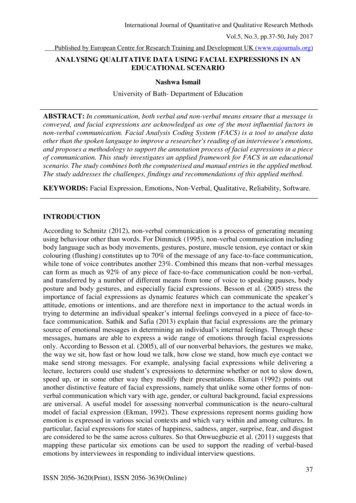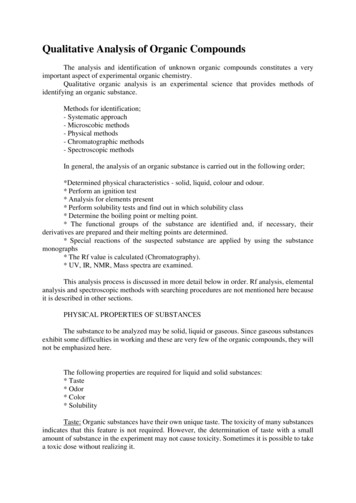
Transcription
Qualitative Analysis of Organic CompoundsThe analysis and identification of unknown organic compounds constitutes a veryimportant aspect of experimental organic chemistry.Qualitative organic analysis is an experimental science that provides methods ofidentifying an organic substance.Methods for identification;- Systematic approach- Microscobic methods- Physical methods- Chromatographic methods- Spectroscopic methodsIn general, the analysis of an organic substance is carried out in the following order;*Determined physical characteristics - solid, liquid, colour and odour.* Perform an ignition test* Analysis for elements present* Perform solubility tests and find out in which solubility class* Determine the boiling point or melting point.* The functional groups of the substance are identified and, if necessary, theirderivatives are prepared and their melting points are determined.* Special reactions of the suspected substance are applied by using the substancemonographs* The Rf value is calculated (Chromatography).* UV, IR, NMR, Mass spectra are examined.This analysis process is discussed in more detail below in order. Rf analysis, elementalanalysis and spectroscopic methods with searching procedures are not mentioned here becauseit is described in other sections.PHYSICAL PROPERTIES OF SUBSTANCESThe substance to be analyzed may be solid, liquid or gaseous. Since gaseous substancesexhibit some difficulties in working and these are very few of the organic compounds, they willnot be emphasized here.The following properties are required for liquid and solid substances:* Taste* Odor* Color* SolubilityTaste: Organic substances have their own unique taste. The toxicity of many substancesindicates that this feature is not required. However, the determination of taste with a smallamount of substance in the experiment may not cause toxicity. Sometimes it is possible to takea toxic dose without realizing it.
Bitter taste: Alkaloids (quinine, morphine, strychnine), quinoline derivatives,glycosides, polyethylene glycol derivatives, barbital, ureites.Sweet taste: Carbohydrates, chloroform, glycol, resorcin, sucrose, sodium salicylate,phenol, etc.Salty taste: Formic acid and acetic acid salts, urea, urethane etc.Burning taste: Chloralhydrate, certain acids, benzoic acid, salicylic acid, resorcin,phenols.Sour taste: Organic and inorganic acids (vitamin C).The substance which make numbness in the tongue: Local anesthetic compounds(cocaine, benzocaine, novocaine, pentocaine, lidocaine, etc.).Odor: Many organic substances have a characteristic odor. The smell of the substancemay indicate which class is a compound. In order to determine this, it should be tried beforehandwhich odor of the compounds of various classes. The odors of alkalines, esters, phenols, amines,aldehydes and ketones are different. When the substance is more volatile, its smell is morenoticeable.For example; coumarin, eugenol, vanillin, ethyl acetate, methyl salicylate, phenols,thymol, menthol, ethanol, acetone, ether, chloroform, amyl alcohol and pyridine have uniqueodors. Sulfur compounds have a rotten egg smell. For example, mercaptans and isonitrile havevery unpleasant odors. Benzaldehyde, nitrobenzene and the like smell like bitter almonds.If a substance has a very noticeable and penetrating odor, it can be considered to be avolatile, small molecule.Color: An examination of color can sometimes give important information about thestructure of matter. A variety of functional groups may be suspected if the substances arecolored. Carbon, hydrogen, oxygen and sulfur-containing substances are colorless. However,quinones, unsaturated side-chain ketones, and very few saturated diketones are colorful amongthese. If the substances are colored, there is the presence of nitrogen. Nitrogen-bearing coloredcompounds include the following: Substituted anilines, toluidines, polycyclic amines,hydrazines, nitro or nitroso or aminophenols, polynitro or polyamino hydrocarbons, nitro oraminokinones, azo and diazo compounds, picrates, ozazones, hydrazones, etc. In all thesecompounds the color changes from yellow to red.The number of double bonds in the molecule and the groups such as C O, C S,O N O, -N N-, -N O also have an effect on color. The substances with the o- or p-quinonoidstructure, or in other words, the substances only with chromophore groups, are generally yellowcolored. If the substance contains a chromophore group as well as an oxochrome groups suchas NH2, -NHR, -OH or ,SH, the color becomes darker.Homogeneity: If the substance is solid, a certain degree of homogeneity control is doneby examining the amount of a few mg of matter under a magnifying glass or microscope. It isseen that a substance that appears homogeneously with the naked eye might be a mixture ofcolored and colorless components under the microscope. Likewise, when the substance thatappears to be the only type with the naked eye is enlarged, it can occur that there is a mixtureof amorphous and crystal components or other kinds of crystals.
Determination of pH of the substance: The pH of the substance can also give some ideasabout that substance. Because some of the functional groups it contains can give acidic or basicproperties. The substance must be soluble in distilled water for the determination of pH. If itdoes not dissolve, the mixture is heated and sufficiently solubilized for pH even if it is notdissolved in the heat. Then red or blue litmus paper determine the acid, base or neutral character.Solubility: It is based on molecules or inter-ionic forces applied by both solvent andsolute. In order to dissolve a substance in a solvent, it is necessary to loosen some bonds in boththe solute and the solvent and to form new bonds between the dissolved ions or molecules andthe molecules of the solvent. If a substance is dissolved in 1 ml of solvent at room temperatureup to 30 mg, this substance is dissolved in that solvent.The following table 1.1 shows the resolution state with the amount of solvent that onepart of the substance can be dissolved:The amount of solvent in which one part of solute is dissolvedResolution statusLess than 1 part . very soluble1-10 parts . easy soluble10-30 parts . soluble30-100 parts . slightly soluble100-1000 parts . sparingly soluble1000-10000 parts.very hard solubleMore than 10000 parts . practical insolubleSolubility experiments should be carried out at normal room temperature. Althoughmany substances are not dissolved in normal temperature, they can be soluble with heat. Thesame is also true for liquids. In this case, it is necessary to mix the liquid with the solvent andnot to form two phases. By looking at the solubility of an unknown substance in the solventsgiven below, an idea about the unknown substance can be obtained in three aspects (water,ether, 5% hydrochloric acid, 5% sodium hydroxide, 5% sodium bicarbonate, sulfuric acid,phosphoric acid).-The solubility indicates the presence of the functional group. For example, ifhydrocarbons are partially soluble in water we can understand that they might have a functionalgroup in their structure because they are not soluble at all.- The solubility in certain solvents gives more important, specific information about thefunctional group. For example, benzoic acid is dissolved in 5% sodium hydroxide, although itis insoluble in water. Thus, the dissolution of a water-insoluble substance in sodium hydroxidesolution indicates a strong acidic group in its structure.
-Referring to the solubility of an organic substance, we can also obtain an idea of themolecular weight of the substance. For example, in the homologous series with monofunctionalgroups, compounds with 5 carbon atoms or less are dissolved in water and compounds with ahigh number of carbon atoms are insoluble in water.Solvents can be grouped into two classes;*Nonpolar solvents*Polar solventsAcidic substances are dissolved in weak basic medium, basic substances are dissolvedin weak acidic medium.There is a principle ”Similar solves similar”. Nonpolar substances are soluble innonpolar solvents, polar substances are soluble in polar solvents. If it is a low-chain substancethen its nonpolarity decreases.As the hydrocarbon portion of a molecule grows, the properties of the substance will besimilar to the properties of hydrocarbons, the solubility in water will decrease, whereas thesolubility in ether will increase. this also applies to aromatic hydrocarbons.In the case of a phenyl ring is present in any part of an aliphatic acid, alcohol or analdehyde molecule, the effect of this ring on solubility is equivalent to the action of an aliphaticradical carrying 4 carbon atoms.In polymorphous substances, the low melting point polymorph has greater solubility inwater.The solubility of small molecular weight substances in water is greater than that of largemolecules. However, there are some cases that do not comply with this rule; For example,amides of the type R-CO-NH2 are less soluble than the R-CO-N(R1)2 derivatives.Since the growth of molecular weight or the formation of the polymer of organicsubstances will increase the intermolecular force, the solubility in water and ether will decrease.Halogen entry into a structure is also one of the factors reducing water solubility. If thehalogen enters the organic structure in salt form, the solubility in water increases.A branched carbon chain-bearing substance is better soluble in water than its straightchain isomers of the same molecular weight.The place of the functional group in the carbon chain also affects the solubility; thecloser the homogeneous group is to the middle of the molecule, the higher the solubility inwater.The solids must be finely powdered to increase the dissolution rate. The solubility of thesubstances given as samples in laboratories shall be made according to the solubility table givenbelow. Thus, the solubility group of the substance will be determined. Determining thesolubility group of the substance as previously described above will give us an idea of thestructure and functional groups of that substance.
Solubility Group Determination:GROUP 1: Generally, compounds with monofunctional groups of 5 or less carbons.Only if C, H and O are present: Carboxylic acids, alcohols, aldehydes, ketones,anhydrides, esters, ethers.-If nitrogen is present: Amides, amines, nitriles, oximes.-If halogen is present: halogen substituted compounds of compounds given in (a).-If sulfur is present: heterocyclic hydroxy sulfur compounds, mercaptoacids, thioacids.-If nitrogen and halogen are present: halogenated amines, amides and nitriles.-If nitrogen and sülfür are present: sulfurated heterocyclic amino compounds.GROUP 2: Only if C, H and O are present: Dibasic and polybazic acids, hydroxy acids,polyhydroxy alcohols.- If nitrogen is present: Aminoalcohols, amino acids, amines, urea.- If halogen is present: Haloacids, haloalcohols, aldehydes.- If sulfur is present: Sulfonic acids.- If both nitrogen and halogen are present: amine salts of halogenated acids.- If both nitrogen and sulfur are present: amino, nitro, cyano sulfonic acids.GROUP 3: Amines, amino acids, aryl-substituted hydrazines, N,N-dialkylamides.GROUP 4: Generally 10 or less carbon compounds:- Only if C, H and O are present: Acids and anhydrides.- If nitrogen is present: Amino acids, heterocyclics, carboxylic acids.- If halogen is present: Haloacids, acid halides.- If sulfur is present: Sulfonic acids, Mercaptans.- If both nitrogen and sulfur are present: Sulfonamides, aminosulfinic acids.- If both sulfur and halogen are present: Sulfonhalides.GROUP 5:- If there is only C, H and O are present: phenols, enols, some high-molecular weightacids.- If nitrogen is present: Aminophenols, nitrophenols, cyanophenols, oximes.- if sulfur present: Thiols, thiophenols. halofenols.- If nitrogen and halogen are present: Polynitro halogenated aromatic hydrocarbons,substituted phenols.- If nitrogen and sulfur are present: Sulfonamides, aminothiophenols.
GROUP 6:- If nitrogen is present: Amides, diarylamines, nitriles, triarylamines.- If Sulfur is present : Sulfides, sulfones, thioesters.- If nitrogen and sulfur are present: thiourea derivatives, sulfonamides, thiocyanates.- If nitrogen and halogen are present: halogenated amide, amine and nitriles.GROUP 7: Halogenated derivatives of hydrocarbons and hydrocarbons.GROUP 8-9: Neutral compounds not containing nitrogen and sulfur.Procedure to determine the solubility groups of substances is given in below table 1.2IGNITION TEST0.1g of the substance is heated in a porcelain crucible with a light flame. The substanceis checked for flames, whether the substance is flammable, then the flame is gradually increasedand burned strongly. The changes in the item now will be evaluated as follows.
Ammonia smell:Ammonium salts, urea and urea derivatives, hexamethylenetetramine.No burning residue and caramel smell during combustion: Tartaric acid, citric acid,dextrin, starch and so on.Mercaptan smell: Sulfonal, trional, thiourea derivatives etc.Phenol odor: Phenol, phenolic compounds.Brown vapors: Bromine, nitrogen dioxide.Purple vapors: Iodine.Acid reaction: Volatile acids.Alkaline reaction: Volatile alkalis.Burning with clear, almost blue flame: substances carrying oxygen.Burning with brig
In general, the analysis of an organic substance is carried out in the following order; *Determined physical characteristics - solid, liquid, colour and odour. * Perform an ignition test * Analysis for elements present * Perform solubility tests and find out in which solubility class
